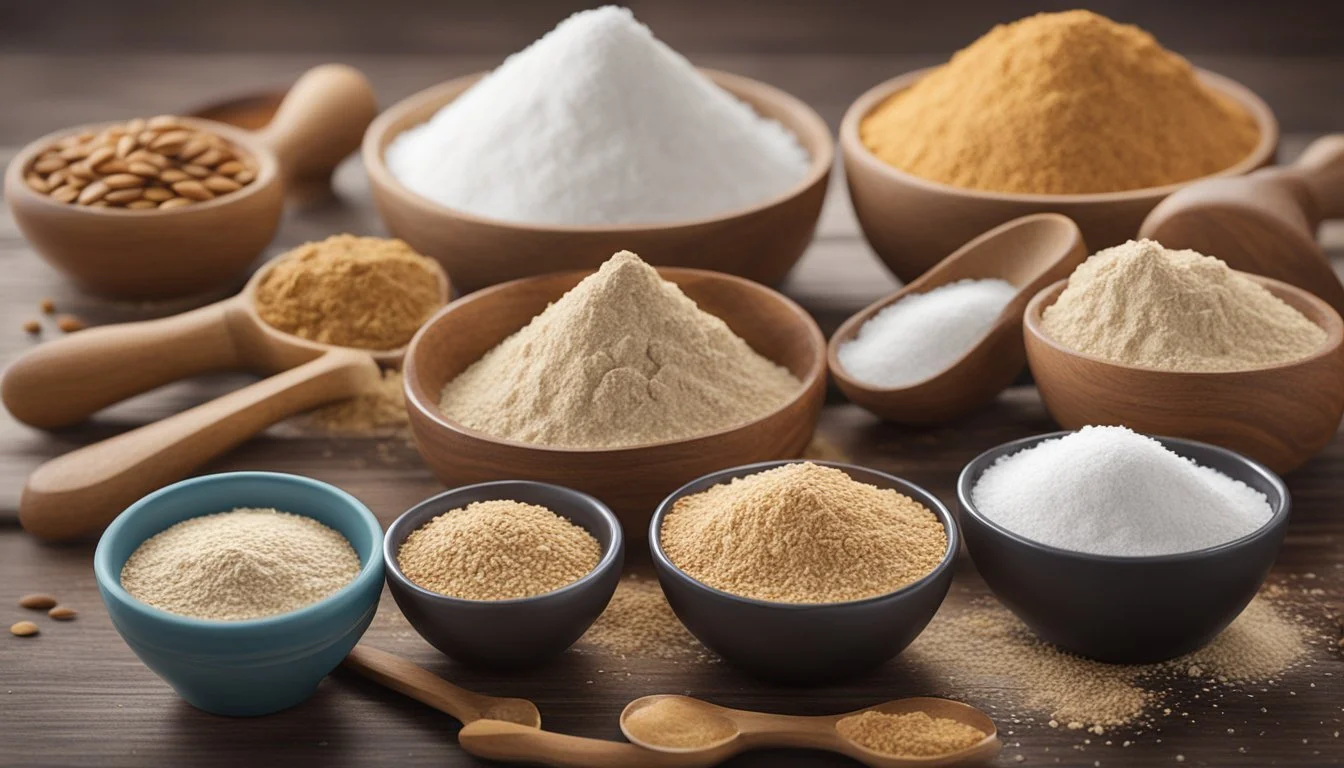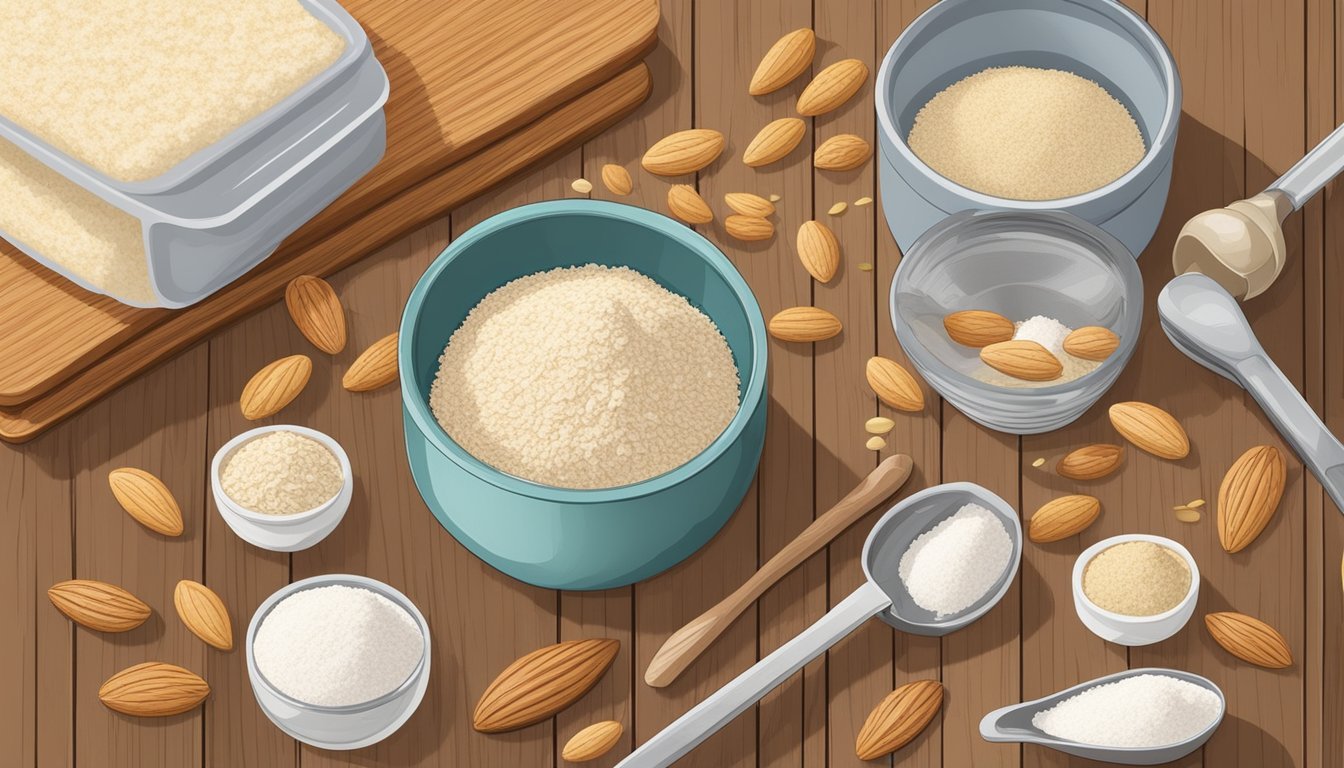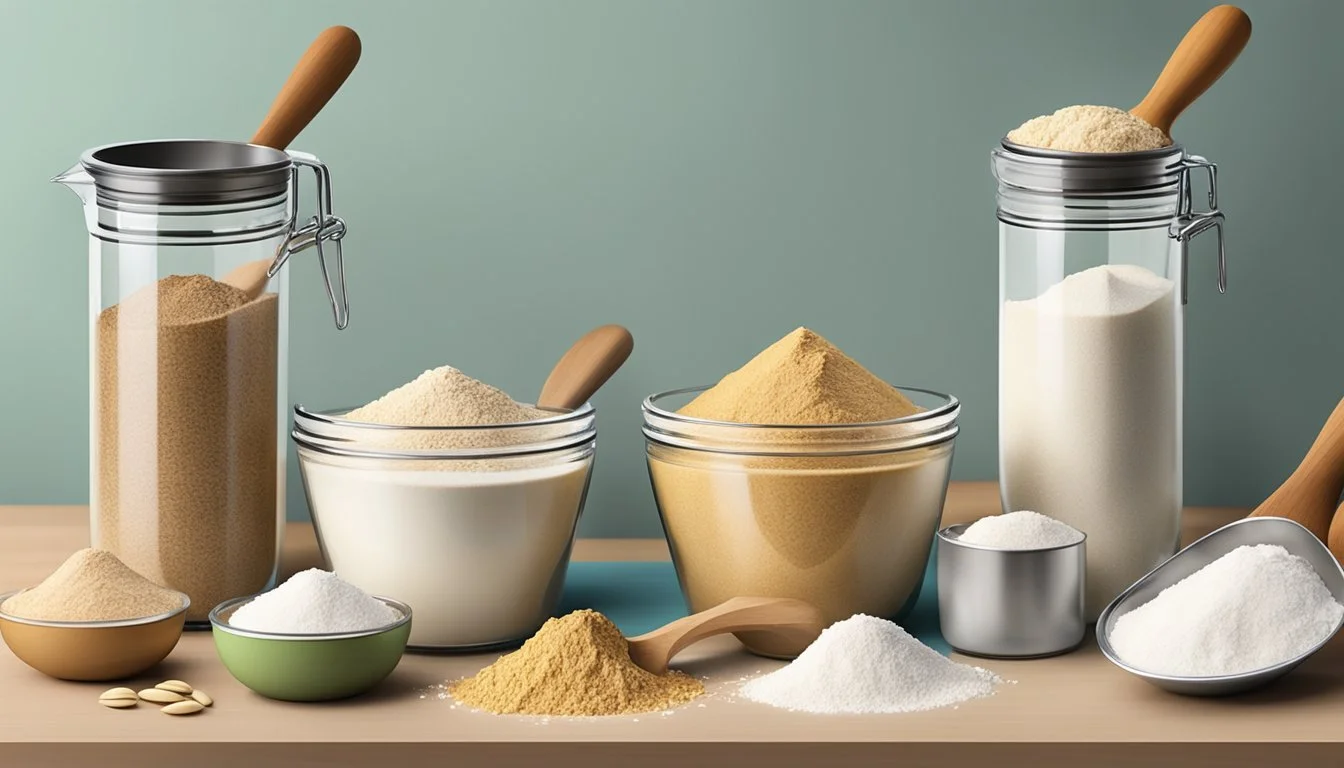Bread Flour Substitutes
Top Alternatives for Baking Success
Baking enthusiasts often reach for bread (What wine goes well with bread?) flour due to its high protein content, which is ideal for creating the perfect loaf with a good rise and chewy texture. However, not all baking adventures go as planned, and there may be times when bread flour is unavailable. This is where the versatility of all-purpose flour comes into play. With its more accessible nature and balanced protein content, all-purpose flour stands as the most common substitute for bread flour, ensuring home bakers can still produce delightful baked goods even when the pantry is lacking the specialty item.
While all-purpose flour can directly replace bread flour in most recipes, it's worth noting the slight difference in protein levels may affect the texture of the bread. Bread flour typically contains around 12-14% protein compared to all-purpose flour's 8-11%, which influences gluten formation. For those looking to mimic the properties of bread flour, adjusting the ratio slightly or adding vital wheat gluten can help achieve a more desirable consistency in the final product. In addition to all-purpose flour, other substitutes such as cake or pastry flour may be used in a pinch, but these require careful blending with higher-protein flours to compensate for their lower protein content and avoid overly dense results.
Understanding Bread Flour
Bread flour is distinguished by its high protein content, which is crucial for gluten development, affecting both texture and structure of the baked bread. Proper understanding of these properties is essential for any baker looking to achieve the desired consistency in their bread products.
Protein Content and Gluten Formation
Protein in bread flour typically ranges between 12% and 14% which is significantly higher than that found in all-purpose flour. The protein, when mixed with water during the kneading process, forms gluten. This gluten network is responsible for providing elasticity and strength to the dough. The elasticity allows the dough to stretch and trap gases produced by yeast, which is pivotal to the bread's rise and final volume.
Effects on Texture and Structure
The interaction between protein and gluten not only affects the bread's rise but also determines the texture and structure of the final product. The high-protein content in bread flour fosters a more chewy and hearty texture, making it ideal for heavier bread like bagels and pretzels. Conversely, lower-protein flours tend to produce a more tender crumb, suitable for cakes and pastries. Choosing the right flour is imperative for bakers who aim for a specific consistency and quality in their baked goods.
Common Bread Flour Substitutes
When it comes to baking, precision is key, and the type of flour one uses can significantly affect the texture and rise of the final product. However, for those in a pinch who don't have bread flour on hand, there are several substitutes that can be used to achieve satisfactory results.
All-Purpose Flour
All-purpose flour is the most straightforward swap for bread flour due to its availability and balanced protein content which falls between 8-11%. While all-purpose flour has less protein than bread flour, it can still produce a commendable rise in bread recipes. Bakers often use a 1:1 ratio when substituting all-purpose flour for bread flour.
Whole Wheat Flour
Whole wheat flour offers a nutty flavor and rich texture to baked goods and typically contains a similar amount of protein as all-purpose flour, around 10-12%. However, because it also includes the bran and germ of the wheat, it can make breads denser and may require additional liquid in the recipe.
Cake Flour and Pastry Flour
For a tender crumb, bakers might consider combining cake flour or pastry flour with all-purpose flour. Both cake and pastry flours have lower protein content, generally around 7-9%, which results in a softer texture. A common blend is a 1:1 ratio of all-purpose to cake or pastry flour for substituting bread flour, yet adjustments to recipes may be necessary.
Specialty Flour Alternatives
When baking without bread flour, one has a variety of specialty flours to consider, each best suited for particular applications and health needs. These alternatives offer options for gluten-free diets, higher protein content, and unique flavors from diverse grains and nuts.
Gluten-Free Flour Options
For individuals with gluten intolerance, gluten-free flour alternatives provide a solution for bread making. A popular choice is rice flour, known for its sandy texture. It's important to mix rice flour with other gluten-free flours for a better texture. Blends of gluten-free flours often include starches like tapioca or potato to improve the final product's consistency.
Common Gluten-Free Flours:
Rice Flour
Tapioca Flour
Potato Flour
Corn Flour
Nut Flours and Other Grains
Nut flours, such as almond flour, offer rich flavor and are gluten-free. They are usually best when combined with other flours to achieve a desirable texture in baking. Beyond nuts, flours from grains like barley and quinoa provide distinctive tastes and nutritional profiles that can enhance bread recipes.
Flavorful Grain and Nut Flours:
Almond Flour: Nutty taste, good for texture.
Barley Flour: Slightly sweet, adds softness.
Quinoa Flour: Nutrient-rich, earthy flavor.
Note: Almond flour is heavier than wheat flour and may require adjustments in the recipe.
High-Protein Flour Substitutes
For those seeking a high-protein flour alternative, semolina flour, made from hard durum wheat, is an excellent choice, especially for bread and pizza dough due to its high gluten content. Another suitable option is spelt flour, which retains many nutrients and is easier to digest than conventional wheat.
High-Protein Flour Choices:
Semolina: Ideal for a chewy texture and pasta.
Spelt Flour: Nutty flavor, high in protein.
Each substitute has its own characteristics that can affect the texture, flavor, and nutritional content of the baked goods. Careful consideration and experimentation with these specialty flours can result in delicious and health-conscious alternatives to traditional bread flour.
Adjusting Recipes for Substitutes
When substituting flours in bread recipes, it's crucial to consider three main aspects: the leavening and moisture content of the dough, the methods for kneading and resting, and finally, the expected taste and flavor of the finished bread.
Altering Leavening and Moisture
Substitutes can significantly affect how the dough rises and holds moisture. All-purpose flour, for example, generally requires the same amount of leavening agent as bread flour. However, it may need slight adjustments in moisture because it has less protein, which affects water absorption. Recipes using almond meal or coconut flour as substitutes will require more significant modifications:
Almond Meal: May need to reduce the amount slightly and add more moisture to compensate for its denser nature.
Coconut Flour: Is highly absorbent, so only use 1/4 cup for every 1 cup of bread flour and increase eggs in the recipe to add more moisture and improve binding.
Kneading and Resting Considerations
When using substitutes, the texture during the kneading stage could be different:
For all-purpose flour, dough might be less elastic, so kneading times might be reduced.
If whole wheat flour is used, the baker should expect a denser dough, requiring potentially longer kneading time to develop the gluten.
Resting times can also vary, particularly if additives like vital wheat gluten are incorporated to enhance the protein content of the flour.
Taste and Flavor Modifications
Alterations to flavor and taste should be anticipated with different substitutes:
All-purpose flour will produce a milder and less chewy bread.
Whole wheat flour offers a more robust flavor and a heavier texture.
Substitutes like almond meal or coconut flour will introduce their distinct flavors and can impact the sweetness and nuttiness of the bread.
Bakers should adjust additional ingredients like sugar or spices accordingly to achieve the desired flavor profile.
Specific Applications of Substitutes
Substitutes for bread flour must be chosen with the end product in mind as they can have significant effects on texture, rise, and flavor.
Making Pizza Dough and Crusts
For pizza dough and crusts, a key factor is achieving a chewy yet crisp texture. All-purpose flour can be used in lieu of bread flour, and while it may not yield the same elasticity due to a lower protein content, it generally produces a satisfactory result. One could add vital wheat gluten to increase the protein content and achieve a closer approximation to bread flour's performance.
Baking Cakes, Muffins, and More
When baking cakes, muffins, and similar baked goods, a tender crumb is desirable. Cake flour is a superb substitute as it has less protein than bread flour, ensuring a softer texture. Pastry flour is also an excellent choice because it strikes a good balance between strength and tenderness, making it suitable for delicate applications, including layer cakes and English muffins.
Creating Artisan Breads and Pastries
Artisanal breads, such as baguettes or focaccia, rely on a strong gluten network, which is intrinsic to bread flour. However, alternatives like semolina flour can be utilized for a robust structure and an interesting flavor profile, often accompanying pasta. For a rustic bread or a bagel that requires a dense texture, a half and half mix of all-purpose flour and whole wheat flour can be considered, providing both the necessary strength and a nuanced taste.
Health and Dietary Considerations
When choosing a bread flour substitute, one must consider dietary restrictions and the nutritional impact of the alternative flours. Specific flours can cater to gluten-free, vegan, or balanced nutrition needs without compromising taste and texture.
Gluten-free and Celiac Disease
Individuals with celiac disease require gluten-free options to avoid health complications. Gluten-free substitutes such as almond flour or coconut flour are viable options. They offer a healthy alternative with a rich, nutty flavor while preventing the adverse effects associated with gluten ingestion. One must ensure the substitute's cross-contamination with gluten-containing grains is avoided to ensure safety.
Vegan Baking with Substitutes
Vegan baking demands substitutes that do not derive from animal products. Semolina flour, although high in gluten protein, is a suitable choice for vegan recipes due to its plant-based origin. It provides a robust structure for breads and pizzas without using traditional bread flour. Additional vegan-friendly substitutes include oat flour and various gluten-free blends, which may require binding agents like flax eggs to replace the elasticity that gluten provides.
Balancing Nutrition with Substitutes
A healthier baking approach often involves balancing the nutritional content. Substitutes such as oat flour not only contribute to a gluten-free diet but also offer a boost in protein and fiber. The table below showcases the nutritional comparison between traditional bread flour and a selection of substitutes:
Substitute Protein Fat Carbohydrates Fiber Nutritional Benefit Almond Flour High Higher Low High Protein-rich, low in carbs Coconut Flour Moderate Higher Low Very High High in fiber Oat Flour Moderate Low Moderate High Balanced in macros, gluten-free
Each of these substitutes contributes a distinct profile of nutrients, catering to those who seek a more wholesome and tailored baking experience.
Frequently Asked Questions
In exploring the options for substituting bread flour, bakers commonly raise questions about the impact on yeast and quick bread recipes, the best ways to store different flours, and the differences between bleached and unbleached flours. The answers to these questions inform both the quality of the bread and the shelf life of ingredients.
Substituting in Yeast and Quick Breads
When substituting for bread flour in recipes involving yeast, the goal is to maintain the necessary protein content which provides structure and elasticity to the dough. One can add 1 1/2 teaspoons of vital wheat gluten to each cup of all-purpose flour to closely replicate bread flour's properties. In quick breads which rely less on gluten, one may substitute all-purpose flour directly, albeit with a potential change in texture.
Shelf Life and Storage of Flours
The shelf life of flour can vary based on its type. Whole grain and wheat flours, which contain more oils from the grain, generally have a shorter shelf life than all-purpose or bread flours. Storing flour in a cool, dry place, preferably in an airtight container, can extend its usability. Flours made from hard wheat varieties tend to have a longer shelf life due to their lower oil content.
Bleached vs. Unbleached Flour
Bleached flour has been treated with chemical agents to hasten aging, which alters its protein structure and results in a softer texture. Unbleached flour is naturally aged and maintains its protein content better, making it closer to bread flour in terms of performance. For those avoiding additives or desiring a stronger structure in their bread, unbleached all-purpose flour is a preferable substitute over bleached varieties.





